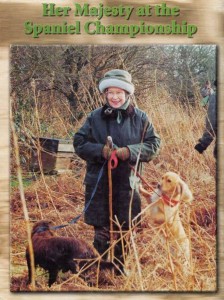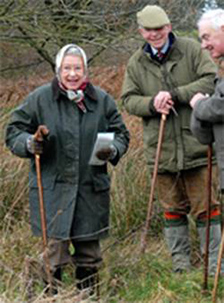SPANIEL HISTORY (part 4)
Father of North American Springers
(Condensed and edited by John Eadie)
THE FIRST SPANIELFIELD TRIAL IN AMERICA
 The first Field Trial for Spaniels ever held in America were held on September 30, 1922 near St. Agathe, Manitoba, Canada, some thirty miles south of Winnipeg. (It was in 1923 that the Fisher’s Island F.T. Club got under way and their first Springer trials were held.)
The first Field Trial for Spaniels ever held in America were held on September 30, 1922 near St. Agathe, Manitoba, Canada, some thirty miles south of Winnipeg. (It was in 1923 that the Fisher’s Island F.T. Club got under way and their first Springer trials were held.)
Before the first brace was put down, Mr. Freeman Lloyd said that this was a most auspicious occasion, as it was the start of the Spaniel Field-Trial movement, which would surely spread and spread, until it reached every quarter of America.
The English Springer Spaniel Club of Canada was formed in July and it was under the club’s auspices that the field trial was held. There were 26 runners in the three stakes and the card was finished in about six and a half hours.
 The trial was reported in Field and Stream, December 1922:
The trial was reported in Field and Stream, December 1922:
THE NOVICE STAKE
“Flora of Avandale and Oak Connie made up the first brace. They were put down in some nice thick brush, poplar and stunted oak, with considerable under-growth, very good covert for rabbits and partridge. They both set merrily to work, being under good command and close workers. Almost immediately Flora chopped a rabbit in her form and when being called, immediately retrieved her game was made up of Oak Cora and the handsome white and black bitch, Patty of Avandale. They immediately settled down to work in the heavy, hot and somewhat bad covert for scent, the morning being dry. It was not long before Patty worked up to a single prairie chicken and dropped to wing and the successful shot. On being sent on, she at once retrieved her game into the hands of her handler, Newton. Shortly afterward, both were steady to wing and shot, to a partridge found by Flora. Again she retrieved with feather, just as she sis with fur. Flora, of course, was awarded the heat.”
“Wocksay of Avandale, a blue roan, and Miss Lucy of Avandale were next called and put down in the same sort of convert. They ran a give-and-take trial, finding several rabbits between them. Both were steady to shot and retrieved. Notwithstanding that MIss Lucy ran under the heavy handicap of being forward in whelp, she performed in a most satisfactory way.”
“The third brace on the card was made up of Oak Cora and the handsome white and black bitch, Patty of Avandale. They immediatly settled down to work in the heavy, hot and somewhat bad covert for scent, the morning being dry. It was not long before Patty worked up to a single prairie chicken and dropped to wing and the successful shot. On being sent on, she once retrieved her game.”
“The next brace brought forward the famous English and Imported dog, Springer of Ware, a big, strong and handsome spaniel of about 57 pounds, and lusty and active enough to retrieve the proverbial swan. Against him was drawn Beauty of Avandale, not nearly the weight of the liver, white and ticked dog, but an extremely active and diligent worker and not afraid to face any cover. The scenting conditions were getting worse and worse, but notwithstanding that, several rabbits were found and when called upon, both retrieved in turn. The Judges announced the following awards: 1, Patty of Avandale; 2, Flora of Avandale; 3, Springbok of Ware. (He fell from grace in chasing a rabbit a short distance).”
THE OPEN STAKE
“There were twelve entries, the first brace put down being Dinah of Avandale and the veteran English field-trial, also international show champion, Don Juan of Gerwyn. In some thick scrub they found three rabbits, and, on hunting a heavy swale of grass, flushed a brace of chicken, which fell to the two guns. The first bird was immediately retrieved by Dinah, and then Don was called upon to accomplish a rather difficult task, to find a running bird. The ten year old dog worked with marvellous sagacity, and, when he found the chicken, quite three hundred yards from where it fell, the company gave the dog `a good hand’.”
“It was now about two o’clock and apparently scent was as bad as it possibly could be. For one hour Imp. Ch. Laverstoke Powder-Horn and the bitch, Flight of Blockley, worked and worked with little success. The field then adjourned for lunch. At one-thirty the above brace was again put down, and the Judges soon realized that it would be useless for the dogs to continue hunting at that time of day and wisely decided to change the ground. They moved about three miles to where there was better covert and more stubble. Here chickens were immediately found and from then on as good work as could be possibly imagined was performed by brace after brace of these spaniels. The birds being already wild because of the evident indiscriminate out-of season shooting, they were flushed at a considerable distance from the guns, which meant that the chickens were not heavily shot and the majority of them were runners of the worst type. Here came the real trials of the day and in no single instance was a bird lost. In only one case did a dog break shot and every bird was found, some of them being in almost impossible places, and brought back to hand in a live state. To run off these heats required from ten to fifteen minutes each because game being plentiful, a spaniel immediately demonstrated by his work what he was worth in the field. The awards were as follows: 1, Ch. Laverstoke Powder-Horn; 2, Ch.Don Juan of Gerwyn; 3, Flight of Blockley.”
THE BRACE STAKE
“The two medium weight bitches, Flora and Beauty of Avandale, were put down in a likely place, in scrub bordering stubble fields on both sides of the main road, near Mr. Botterill’s farm, close to Niverville. In two minutes Flora found and flushed a covey of six chickens, the gun on the inside of the fence (Mr. Barber Haynes) neatly dropping his bird, to be at once retrieved by Beauty. Like many others, this was the first spaniel trial this well-known magazine writer had seen, the Outer-Recreation correspondent exclaiming: “That work is good enough for me!” The covey was marked down in a little-used farm road, full of splendid cover and called for Springbok of Ware and Miss Lucy of Avandale. Now commenced the prettiest work of the day. Another covey was found in this road and the three guns were kept busy, one in the middle of the road, and the two others outside the fences. Still the birds were very wild, with the exception of a partridge which rose right between the dogs. He immediately dropped to the gun of George Kynoch and Mr. Chevrier on the right hand, Gerald Griffin on the left accounted for all of their birds at long distances, each chicken being a strong runner. In due course every victim was retrieved, the quickness of Springbok’s work being particularly noticeable. This powerful and very active dog comes back at a gallop and his mouth on this occasion appeared to be all that could be desired.”
“In the length of about four hundred yards on the old road, the trials were soon completed, the last being Flight of Blockley and Ch. Laverstoke Powder-Horn. Flight had only arrived in Winnipeg from England five days before the trials. Notwithstanding that she had never seen a chicken, she worked like a veteran. It was her lot to be told to retrieve a particularly wily runner which had secreted himself in a pile of straw near a fence. In some marvelous way she picked up the line and almost as quick as thought had found the bird and retrieved it in faultless manner. This remarkable work by a newcomer rang down the curtain on a most successful day, a day that marked the inauguration of field-trials for spaniels in North America. Looking back over the performance on Saturday, September 30th, 1922, your correspondent cannot conclude this report without expressing himself in the highest admiration of the work accomplished by Ch. Laverstoke Powder-Horn, which Mr. Chevrier recently purchased from Lady Portal, England. The smartness of this dog is a long way above the average and time and again he was observed to actually leap over obstacles such as difficult brush, in a manner that would have done credit to a dog of much greater height and weight. In short, he appeared to be a spaniel equally adept at forcing himself through the most vicious undercover, as always demonstrated when he was called upon to retrieve his game; indeed his promptitude was ever notice-able. Following were the awards in the Brace Stake: 1. Ch. Laverstoke Powder-Horn and Flight of Blockley; 2. Flora of Avandale and Beauty of Avandale; 3. Springbok of Ware and Miss Lucy of Avandale.”



